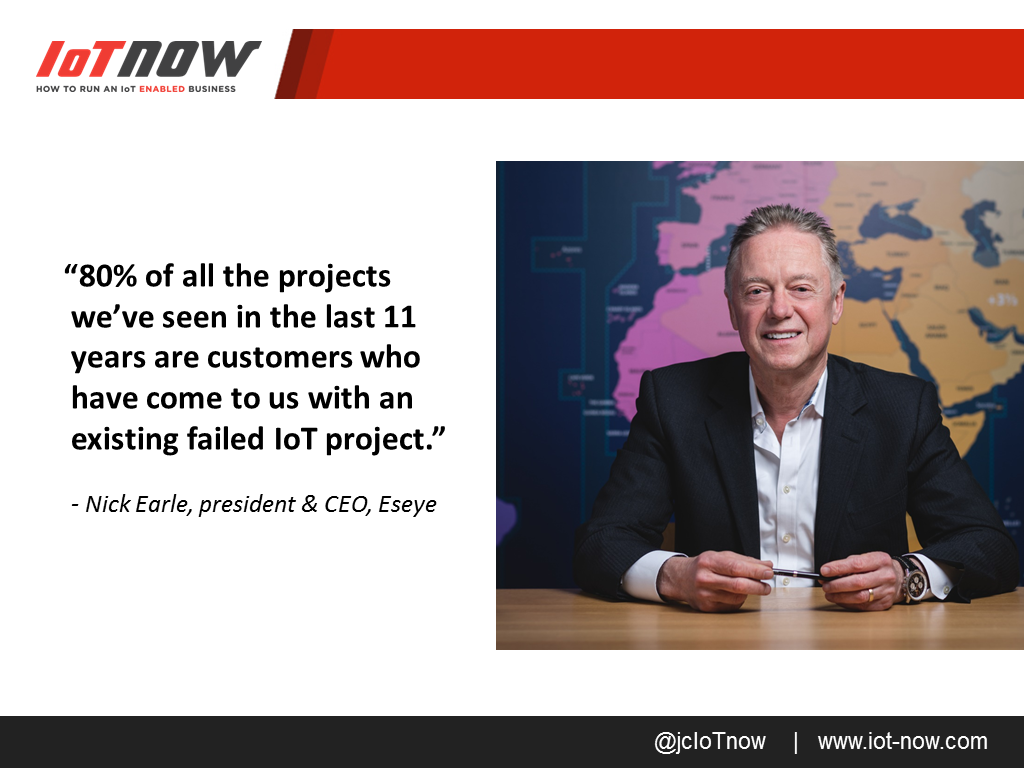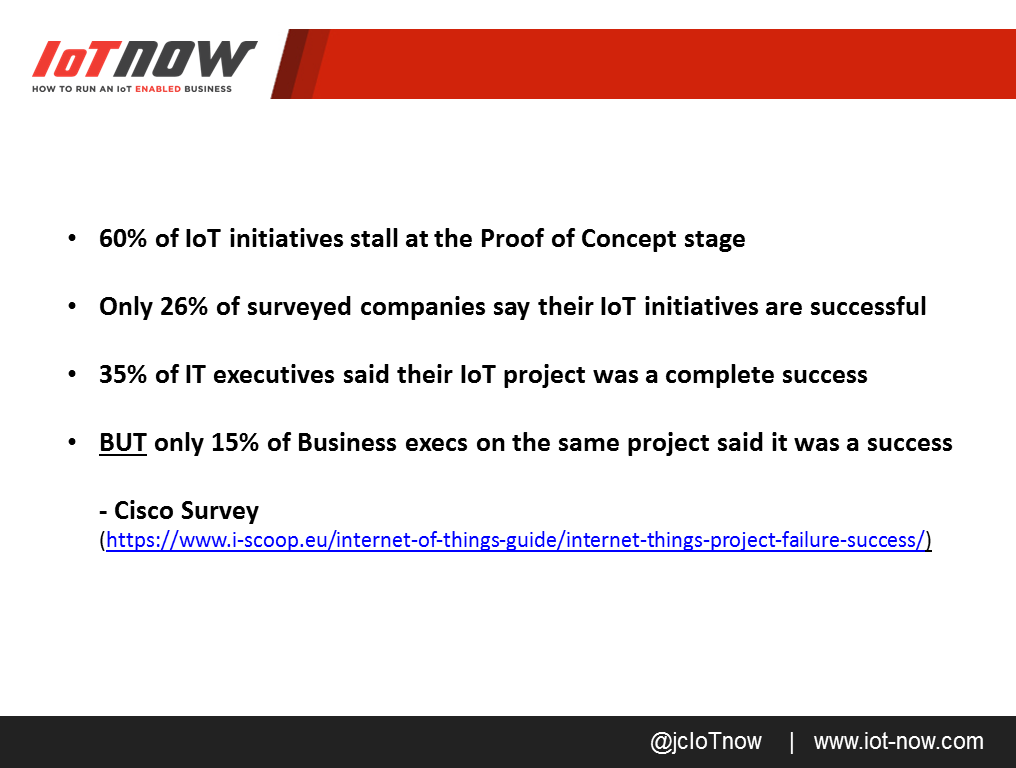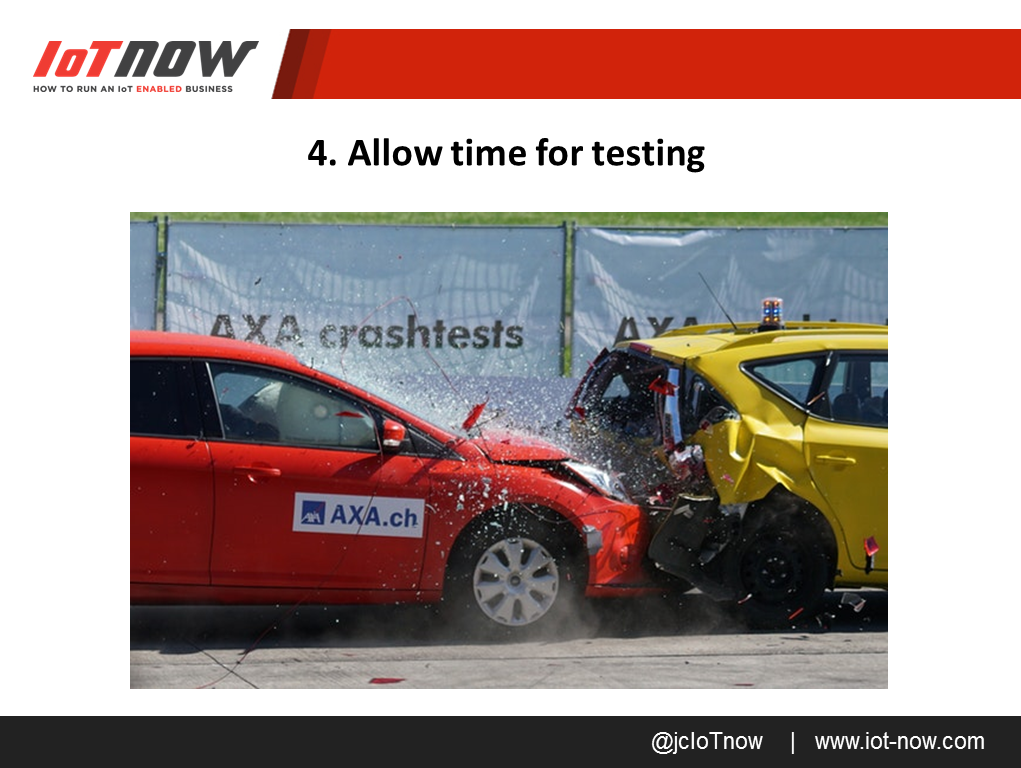When Jeremy Cowan, IoT Now’s editorial director & publisher, was asked to moderate and open the 7th IoT Forum CE (June 5th, Vienna, Austria) the brief for his presentation was “Industrial IoT: Where are we going?” By the time he’d finished drafting it, it had turned into “Where are we going wrong?” Here is his paper.
“When people come on stages like this, they generally tell you all about their successes. But I want to do something different. Today I want to talk about IoT failures.
Put enough beer into enough IoT people and they will share their failures; it’s fun but it’s not a very scientific approach. And I want to drill a little deeper, to understand why Internet of Things failures happen and how they can be avoided or minimised in future.
How NOT to fail in IoT!

Why this interest in failure?
It was triggered by a conversation a few months ago with Nick Earle, the president & CEO of Eseye. In case you haven’t come across Eseye before, they have 1,400 customers, ranging in size from start-ups to Amazon Web Services. Eseye provides IoT connectivity for Costa’s internet-connected coffee machines. In the course of a long and fascinating chat with this experienced CEO and David Thompson, Eseye’s marketing director, Earle said something that stopped me in my tracks.
What is going wrong?
The most common problem, according to Eseye is that the device is not designed for the business case. Companies often adopt the wrong Connectivity Plan. With the wrong plan there may be no way to identify the reason for the connectivity failure. If they have the wrong plan, do they have the right plan for a Solution, for Testing or for Deployment.
I left the meeting and began to look for more facts and figures, for some research to back up this shocking assessment of the Internet of Things.
There was some, but not all of it recent. Cisco conducted a survey in 2017. And guess what? They found that Yes, it is a big problem.

- 60% of IoT projects fail at Proof of Concept stage
- Only 26% of companies say IoT initiatives succeed
- 35% of IT executives said their IoT was a complete success
- BUT only 15% of Business execs on the same project said it was a success
Cisco’s figures suggested that six in every 10 IoT projects fail at the Proof of Concept stage. In fact, only 26% of companies responding to the survey could say that their IoT initiatives had succeeded.
Of almost equal concern, 35% of IT executives questioned said their IoT was a complete success. But only 15% of Business executives working on the same project agreed it was a success.
Evidently, something is going wrong too often in IoT planning, testing, and deployment. Projects that look good on paper are falling short on delivery.
Partner for expertise
It may be no surprise that Cisco suggests that you find the necessary skills by working in a partner ecosystem.
From my own discussions with enterprise users of IoT solutions, it is clear that project complexities are frequently underestimated at the start. So, the right partnerships are key. Do you have the skills in-house? If not, which partner can provide them?
If you’re thinking that these points sound like routine planning requirements, perhaps planning failure is routine, too? And if plans are failing, it’s hard to escape the conclusion that this begins as a failure of leadership. Executives must buy-in to IT and business goals. Ask yourself, does your IoT project have the active engagement of senior leadership in your organisation?
Of course, even within your ecosystem there can often be a gap between the aims of the IT and Business teams. Have you checked that your Business Case and Technical Objectives are aligned?

Someone else who has been talking about failures is David Linthicum, now Deloitte Consulting’s chief cloud strategy officer. He put it well writing in Techbeacon when he said, “Today, risks are greater than losing your job. Failing with an IoT system could result in a catastrophe that makes national news, rather than just an annoying software bug that you fix during the next sprint.” Time is short, so here are a just few key points that may help you cut the risk of failure.

Strategy first
Strategy first, not Technology is the advice from Rami Avidan, CEO of T-Systems, Deutsche Telekom’s enterprise customer unit. IoT Now interviewed him recently to learn about common mistakes in deploying the Internet of Things.
“When this concept of IoT started 20 years ago,” said Avidan, “we all came at it from a technological angle. We were trying to create value from that rather than from strategy. Players that fail today look at IoT from a technical perspective, but this is NOT a technology play. Anything you want to do today can be done with technology. So, focus on the strategy of what you want to achieve.
You need alignment in the boardroom of what the value is going to be, and an understanding that this is going to be a long-term process.”
So, it seems the old business adage applies in IoT; Think Big, Start Small.
Security
Security must be a primary planning concern. It has been said before, but it is still surprising how often it is treated as a bolt-on element at the end of the project. It is also vital that security solutions involve the whole ecosystem from the get-go.
It should be obvious, but perhaps it isn’t to everyone, that all data should be encrypted. Let’s face it, we’ve all heard some horror stories about hacking into connected toys like the Cayla dolls, or into devices in the workplace. And IoT devices can be easy to break into (if device makers allow them to be). So, if you assume that someone is trying to access your IoT network you won’t go far wrong. To black hat hackers, IoT devices are simply another potential entry point to your core network and to other connected devices.
APIs
As Linthicum says, Application Programming Interfaces (APIs) must also be monitored 24/7 for misuse, don’t wait to see if there’s trouble.
You can expect problems if the APIs aren’t well-designed. You should provide sample code for device access and control. And make sure you write user and developer documentation for IoT-based systems. One day, someone will do something they shouldn’t with your IoT system. If you don’t have an audit trail showing that they were told what to do, you’re the one that could be sued.

Testing
You know this I’m sure, but testing is crucial to check that your systems function correctly. IoT systems are sensitive to performance problems. Robotic failures can slow down an assembly line, costing thousands of dollars per hour. Performance issues are often traced back to insufficient testing, bad engineering, or bad API design.
Time is short, so this is just a brief run-down on some of the advice out there on How to Avoid an IoT Failure. At IoT Now we wish you many happy, successful projects.”
The author is Jeremy Cowan, editorial director of IoT Now
Comment on this article below or via Twitter: @IoTNow_OR @jcIoTnow










